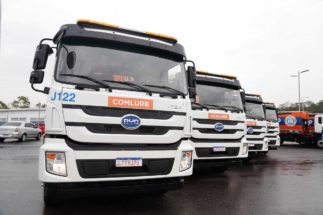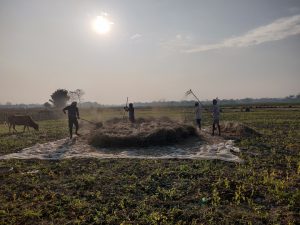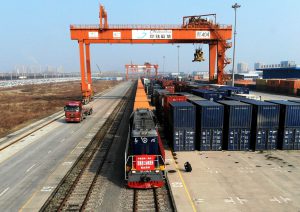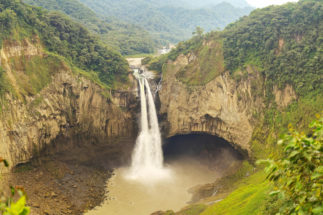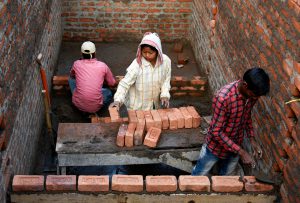The Hindu Kush Himalayan (HKH) region is the water tower for most of Asia, but many of its residents face increasing water insecurity. Approximately 210 million people live in the region divided across eight countries – Afghanistan, Bangladesh, Bhutan, China, India, Nepal, Myanmar and Pakistan. The rivers that stream out of the mountains provide water for another 1.3 billion people living in the plains, but the communities living within the mountainous regions are often neglected. The crisis is worsening. Half of the springs in the region – the major source of water supply – have either turned from perennial to seasonal, or dried up completely.
A recent report by the International Centre for Integrated Mountain Development (ICIMOD) based in Kathmandu, Nepal, throws much needed light on the drivers of water scarcity in the HKH region. Published in Water Policy, the article, based on research which looked at 13 towns in four countries – Bangladesh, India, Nepal and Pakistan – shows that a complex set of factors are leading to the problems.
The devastating impact on local economies as traditional forms of livelihoods are undermined cannot be overstated.
According to the article, the five areas that intersect to cause the crisis are
- Lack of sustainable sourcing of water;
- Failing models of water governance;
- Inequitable distribution of water;
- The ignored role of women in water governance; and
- The increasing impact of climate change.
![Map of HKH showing the towns included in the study: Murree and Havelian in Pakistan; Kathmandu, Bharatpur, Tansen and Damauli in Nepal; Mussoorie, Devprayag, Singtam, Kalimpong and Darjeeling in India; and Sylhet in Bangladesh [image by: ICIMOD]. This is a physical map and does not show any political boundary.](https://dialogue.earth/content/uploads/2020/03/ICIMOD-study.jpg)
It is an interesting choice to put climate change impacts last. The HKH region is heating up faster than other parts of the world, with higher elevations of the Tibetan Plateau showing the fastest rise in temperatures. It is the downstream impacts of climate change that are less well studied. One of these is directly on livelihoods. Across the region, from Kinnaur and Spiti Valley in India, to Mustang in northern Nepal, the cropping patterns of people are changing. In Kinnaur and Mustang, the flourishing apple industry has been undercut. In contrast, in Spiti Valley, people are shifting to apple orchards because their crops are failing.
The devastating impact on local economies as traditional forms of livelihoods are undermined cannot be overstated. This links directly to the first point that the recent paper by ICIMOD highlights: a lack of sustainable sourcing for water. As livelihoods are undermined in the rural economy, people either travel out of the region to earn, or they migrate to towns and cities to find opportunity. As the study notes, in 2001 “only 3% of the total HKH population [lived] in larger cities and 8% in smaller towns (Basyal and Khanal, 2001)”. But projections show that “by 2050, more than 50% of the population in HKH countries will live in cities (UNDESA, 2014).”
While the pull factor of opportunity in urban areas is a major incentive, so is the push factor of declining productivity and opportunity in rural areas. Cities and towns in the HKH region, initially designed for much smaller populations – if designed at all – now have to deal with the inflow of much larger numbers, and that too of people in distress. Managing water sources becomes far more difficult in such circumstances. While governance models can be improved, or can adapt to changing situations, they are now overburdened by an additional inflow of a distressed, unstable, population.
The biggest impact, of course, is on urban development. With a large number of new arrivals and space at a premium, the wetlands, spring recharge sites, and other peri-urban areas critical for the sustainable water management of urban areas are often “developed” in a haphazard manner – often just cemented over. This undercuts the water management of the urban areas still further. Communities resort to the exploitation of groundwater resources, driving the water table still further underground. Some of these towns are also tourist sites, and often cater to populations far beyond their carrying capacity, leading to acute water stress.
Rich households spend 38.2% less on water than poor households.ICIMOD
Two groups pay a very high price for these outcomes. The first is already marginalised communities, such as oppressed caste communities, who have historically not been able to access water as readily as others, with their homes often far from water supply points. In towns catering to new immigrants, the poor pay a far higher price for water, which is often available only through informal means. The authors state that “20% of Kathmandu’s poor households do not have access to the formal water supply system and they end up paying more for accessing water as compared to the richer households who have access. The study also found that the poor spend a greater proportion of their income on meeting their household water needs which means a much greater financial burden. Rich households spend 38.2% less on water than poor households.”
The second group paying this price is women, who almost always bear the burden of collecting water for the household. While this holds true for urban areas, the responsibility in rural areas – from which men migrate out to earn money and send remittances back – is of another magnitude. In these areas the traditional burden of getting water remains, but what is added is their role as farmers and managers of their lives, and – often enough – their surrounding ecosystems. In a number of cases this has led to greater confidence among women, the establishment of women’s groups, and better local governance.
See: Lives without men
As the authors emphasise in the study, the key question for the communities in this region is better coordination, planning and management. To be successful this approach needs to understand the ecology of the towns of the HKH region. A regional Himalayan Council which brings the local governments from across countries together to learn from one another has long been discussed, but has not moved forward although there are some indications of one emerging within India alone. Such a framework will not work unless heretofore marginalised communities and groups are left out of the decision making process, as has happened too often in the region, especially when it comes to hydropower projects. Lastly, if the urban areas are to be managed properly, due attention must be given to rural areas. No matter how smart or well-designed a city is, if it is on the receiving end of a caravan of distress from rural areas, it will also become a breeding ground for misery.
![<p>This spring in a village of Nepal’s Darchula district was repaired by the women of India and Nepal working together; women from India cross the Mahakali every day and come to the spring for water; Chandra Samantha sits by [image by: Minket Lepcha]</p>](https://dialogue.earth/content/uploads/2020/02/Minket-story-3-Chandra-Samantha.jpg)

![Farmers carry a sack of harvested clover to feed their animals, near Khuspur village, Punjab Province, Pakistan [image: Alamy]](https://dialogue.earth/content/uploads/2020/03/E62ENH-300x200.jpg)
